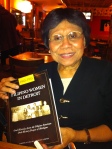School landscaping projects coming into fruition for the fall
September 21, 2011
 |
| Sign at outdoor classroom at Nsoroma |
DETROIT – Work on four landscaping projects at four Detroit schools has been all but completed as the EMEAC Greener Schools Program closes out its Ugliest School Yard Projects at Palmer Park Preparatory Academy, Detroit Community Schools, Detroit Institute of Technology and Nsoroma Institute.
“Most of our projects were completed this summer,” said EMEAC Volunteer Coordinator Kim Sherobbi. “DCS and DIT were our newest projects. Of course, Nsoroma and P3A projects that were started last year, didn’t need as much work done at the end of the school year. The other two schools were a little more labor intensive, but all of them have gone well.”
The projects at the elementary level schools, P3A and Nsoroma, involved the construction of an outdoor classroom space as an alternative learning environment for students and teachers. The projects also included other environmental enhancements. For instance, volunteer Eddie Stucky helped students at P3A build sitting benches and a trellis will be added to the outdoor space this fall.
At Nsoroma, an Afro-centric charter school, environmentalism and alternative learning models are nothing new. Sherobbi says she’s hoping that the school’s new outdoor space will fit nicely into the school’s cultural context.
 |
| Lizzy Baskerville works with a DIT student this summer |
“Nsoroma often uses space outside the school walls to conduct classes and they were doing that before EMEAC got involved, so to actually have a space which was created and implemented by the students is something special for them.
At Nsoroma, they walk in the morning in meditation. It’s usually in quiet but sometimes it’s in conversation. It’s important for their students to can connect with nature and get centered. Along this walk, the students created a meditation path which includes an outdoor classroom. The art teacher assisted her students in creating a sign for the outdoor space.
At both P3A and Nsoroma, MES Lab instructors Sanaa Nia Joy and Priscilla Dziebuek encourage teachers to use the outdoor classroom so students can enjoy the environment and nature while learning.
The high school level projects at DSC and DIT involved projects that were likewise designed to enhance the atmosphere of the respective schools.
 |
| Sign at Palmer Park Academy |
“DIT students who participated in the project wanted to change the appearance of their school entry way,” Sherobbi said. “They wanted their peers to start school in a positive frame of mind and hoped that the landscape design would help.”
Meanwhile at DSC, the students decided to go with a project that brought back a piece of the school’s past journey to its present location.
“DCS built a beautiful gazebo,” said Sherobbi. “They only have a few finishing touches to add to it. They had a gazebo at their former school building and I think they miss that gazebo so they used their money from the Ugliest School Yard to build a new one.
“DCS did most of their work. They are pretty self- sufficient. (Former Greener Schools Director) Lizzy Baskerville did a lot of work with them over the summer. They just wanted to add to their landscape and beautify. In the process, the students picked up lessons in math and science and also in working with each other.”
In the process of recapturing that lost piece of their past, students often found knowledge that will help them build their future.
“When I was talking to one of the administrators, Candyce Sweda at DCS, told me a story about a young man who learned a math lesson,” Sherobbi said. “Ms. Sweda had explained to him the importance of using calculations and getting measurements. At first, he was like, ‘Oh I can do it.’ So, she kind of let him do his thing. Then afterwards when he couldn’t quite get it done properly, he look at here and said, ‘Oh. I guess that’s why we are supposed to measure.’
There are all kinds of stories that were coming up throughout the process. There are some lessons in terms of how do we really make sure that community is a more an integral part of the process. There is some ownership in the schools and community but from everything I’ve heard that is something we may need to spend a little bit more time on.”








